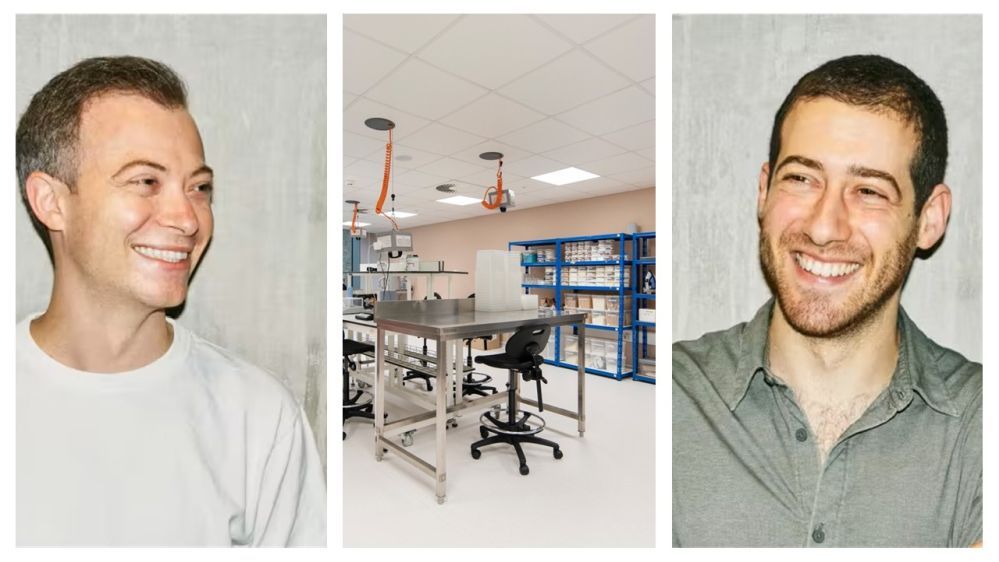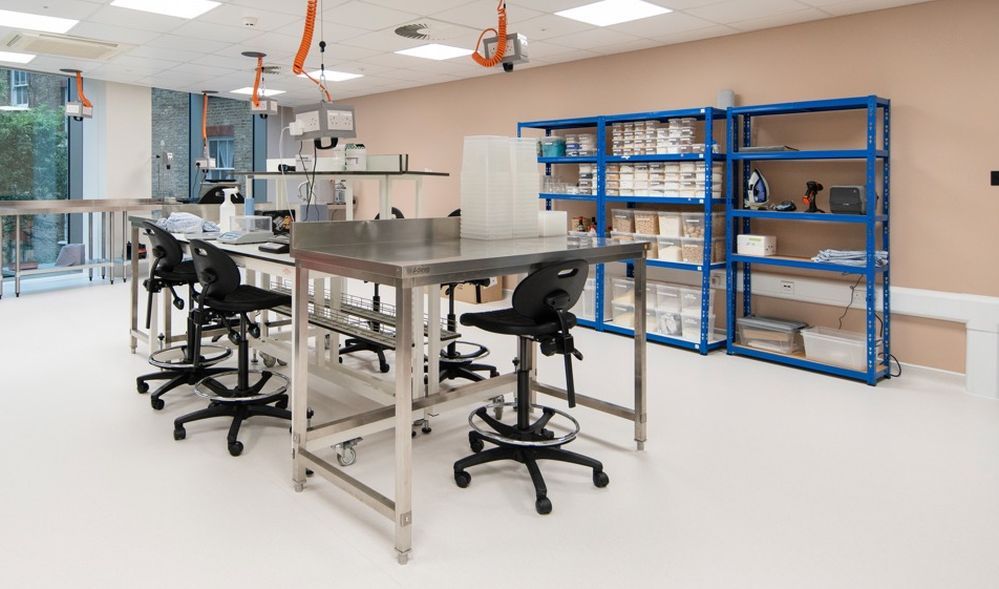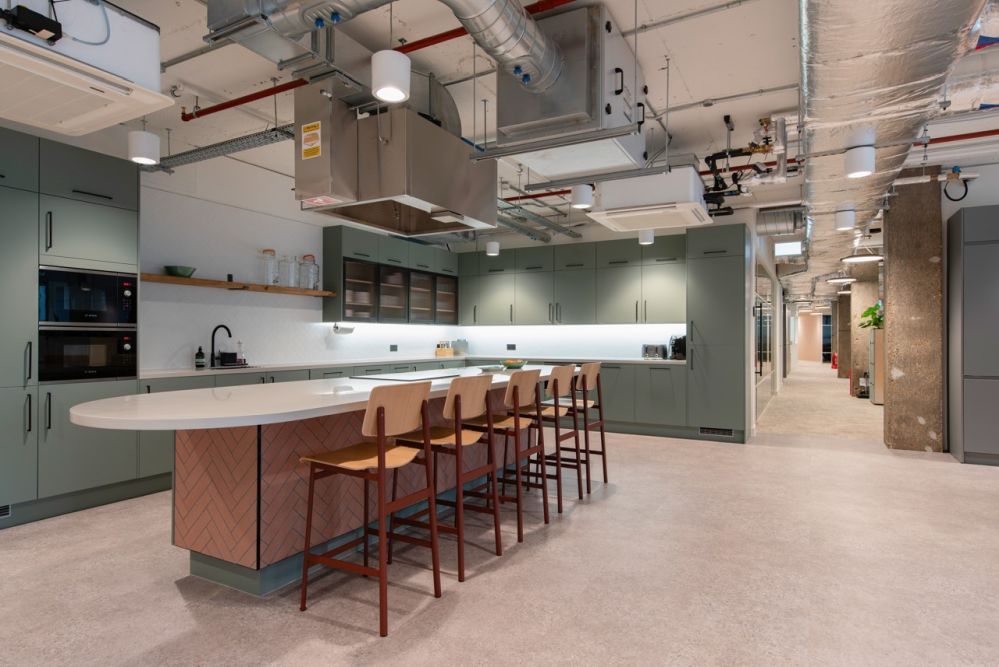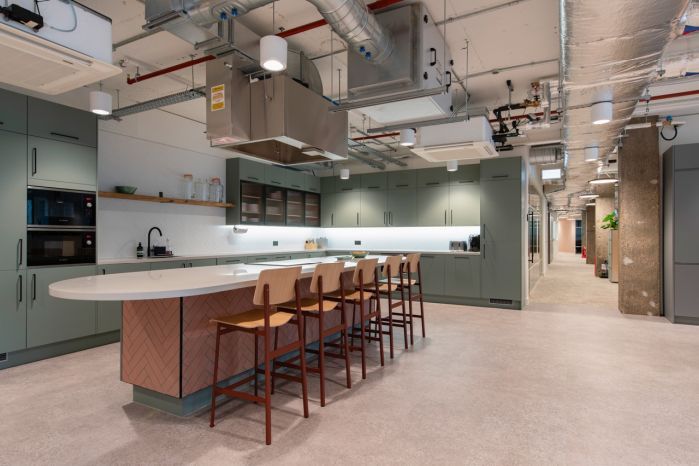[Disclosure: AgFunderNews’ parent company AgFunder is an investor in Hoxton Farms]
UK-based startup Hoxton Farms has opened a pilot facility in London to make cultivated fat, the “magic ingredient that makes meat smell, brown, sizzle, and taste incredible.”
The 14,000-sq ft site in Old Street, central London, will have a capacity of up to 10 tons/year, and features cell culture laboratories, a food development kitchen, office space, and communal areas. It also houses a workshop enabling the team to manufacture proprietary bioreactors designed to optimize fat cell growth with much lower capital costs than industry-standard bioreactors.
The facility has been funded from a $22 million series A round announced last October led by Collaborative Fund and Fine Structure Ventures, with further investment from Systemiq Capital, AgFunder, MCJ Collective, and others.
Cultivated fat: ‘It’s a lot more scalable than muscle and it grows faster’
Founded by synthetic biologist Dr. Max Jamilly and mathematician and computer scientist Ed Steele in 2020, Hoxton Farms is one of a handful of startups developing fats for meat alternatives, a hot area of development in the alternative protein space with applications in plant-based and cultivated meat.
While some players in the field are engineering microbes to produce animal-like fats and others are structuring fats using microencapsulation or oleogelation, Hoxton Farms is growing animal fat from animal cells in bespoke bioreactors.
“Meat alternatives don’t taste good enough, and it’s the key reason that consumers don’t repeat purchase,” Jamilly told AgFunderNews. “Key to fixing that disappointment is fat. If you can’t get the fat right, it’s impossible to recreate the experience that meat eaters crave.
“And, of course, there are many other advantages to fat too [in the cellular ag space]. It’s a lot more scalable than muscle and it grows faster.”
Hoxton is building a platform for making all kinds of fat, but its first product is cultivated pork back fat, said Jamilly. “We’re taking stem cells—MSCs [mesenchymal stromal cells]—from adult pigs and we use endogenous genome engineering to immortalize the cells [so they will divide indefinitely] so we never have to go back to the animal.
“We bank them in the freezer, and each time we start the process, we take an infinitesimal number of cells out of the freezer, put them into the reactor, and they grow over a three-, four-week process.”
“Hoxton Farms’ ability to optimize cost, scalability and time to market demonstrates it can deliver a commercially viable product to market incredibly quickly.” Jennifer Uhrig, senior managing director, Fine Structure Ventures

Fat cells: They are what they eat
Asked about the unit economics of growing cell-cultured fat, Jamilly said: “It’s challenging, but in some ways, it’s easier for fat [than muscle]. Fat cells grow faster, and we all know it’s much easier to sit at home growing fat than to build muscle in the gym.
“But on the flip side, developing really tasty fat with the right flavor profile means you need to think really carefully about what you put in the media because the cells are what they eat. So we can customize the finished fat to produce this incredible diversity of different flavors that you find in nature.
“And maybe one day we can make fats with a taste, melting temperature, or performance that nature hasn’t even invented yet, which is pretty cool.”
Differentiation efficiency and fat accumulation
A key part of driving down costs is optimizing media formulations to get cells to grow as quickly as possible, with high rates of differentiation [more cells that turn into fat], and high levels of fat accumulation, said Jamilly.
“So we’re always trying to increase the proportion of the cells that differentiate, but we’re also looking at how much fat do they accumulate? How big and delicious are the droplets inside the cells? And that really matters. If you look at traditional pig fat, the size of the fat droplets has a really big effect on the taste and the way the fat cooks.”
While differentiation efficiency can be increased with small molecules, he said, “there are certain limitations on what you can safely put into the media depending on regulations. But there are also other levers to pull, such as choosing better cells or engineering them to make more fat. A lot of the work comes before you even add the media to the cells.”
Machine learning
While third parties from ORF Genetics to Future Fields are focused on bringing down the cost of some key components in cell culture media, the recipe itself is something Hoxton Farms is developing in-house, said Jamilly.
“We’re developing media formulations in house. Although there are some one-size-fit-all type media recipes, what you need is the perfect combination of ingredients that works with your cells and your bioprocess, and what we’re focused on is optimizing everything all at once.”
He added: “Consumers won’t switch to meat alternatives unless they’re affordable, so you have to get the unit economics right at scale, and we’re uniquely well placed to do that with my background in biology and Ed’s in maths and machine learning, which allows us to model the entire process and then optimize it using machine learning.
“So we run searches to find the best possible way of feeding and growing the cells to achieve the most scalable and cost effective process and we can do it way faster than if we were running those same experiments in the lab. Developing serum-free media is something we’re really good at as a company. It’s a big computational optimization problem.”
Structured fats
So how, well, fatty, is the stuff coming out of Hoxton’s bioreactors?
“When the fat comes out of the reactor, it looks a lot like the fat that comes from the butcher,” said Jamilly. “It sticks together. It has not just the texture but also the taste and the cooking performance of pork fat. But depending on the kind of product you’re making, the structure matters more or less.
“So the low hanging fruit is unstructured products like burgers and sausages, which is where most of the meat alternatives market is focused today. And it’s very easy with our ingredients to plug into that without manufacturers having to change their recipes or manufacturing set up. Indeed, chances are that [if they add cultivated fat to their formulations] they can remove a lot of the salt and flavorings they use right now to make up for deficiencies of coconut oil [the most commonly-used hard fat in plant-based meats].
“But the more exciting longer term goal is to build fats for more structured [whole cut type] products and things like bacon and pork belly and that’s where our ability to make structured fat comes into play. It’s harder to do, but we’re getting very good at that, although I can’t go into details about how we’re doing that just yet.”

‘The point of this pilot facility is to prove we can make cultivated fat at really competitive unit economics’
As for bioreactors, Jamilly couldn’t go into detail, but said Hoxton Farms is developing “specialized reactors that make the most of the way that fat cells grow and allow us to achieve really high cell densities and yields very cost effectively at scale without the capex required to scale up traditional stirred tank reactors.”
The new facility in London has “more than 1,000 liters of culture capacity for pilot scale production that will correspond to at least a ton of annual output of cultivated fat, and we expect to get there in 2025,” said Jamilly, who is initially targeting the US and Singapore. “And then we’ll go up from there.”
He added: “The point of this pilot facility is to prove the concept, to prove that we can make cultivated fat at really competitive unit economics, and to allow us to start working with our b2b customers, build agreements, and get regulatory approvals.”
The initial market will be plant-based meat, he said, noting that while some brands in this space will not want to compromise their 100% plant-based credentials, many are targeting meat eaters who will not balk at seeing animal fat on a label.
Hoxton has also had “early conversations” with cultivated meat companies, many of whom have initially focused on muscle cells, he said.
As for funding, he said, “Great companies are still getting funded, and in many ways this recent market turbulence strengthens our value proposition because we’re about making products that are affordable, and at least as good as, if not better than, traditional meat.”





